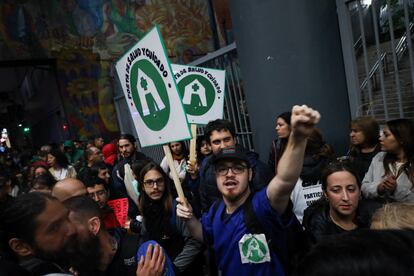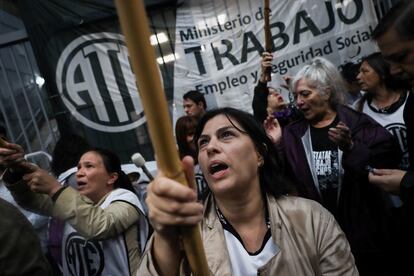Argentina’s public sector unions challenge Milei
Government workers protest over redundancies in front of ministries and the headquarters of public organizations, and teachers’ unions call for a strike


The Argentine public sector is up in arms against Javier Milei. It has borne the brunt of the ultraliberal president’s chainsaw attack. On Wednesday, hundreds of people protested outside the doors of ministries and state agencies over the recent dismissal of nearly 15,000 workers from the country’s public administration, whose annual contracts expired on March 31 and were not renewed by the government. This Thursday it will be the turn of public education. Teaching unions have called for a one-day strike in protest against the cutting of the teacher incentive fund (Fonid), which the state used to financed part of the staff’s salaries.
In the official headquarters, the atmosphere is increasingly tense. “Workers unite, and if you don’t like it, screw you, screw you,” chanted the protesters who unsuccessfully tried to enter the Ministry of Labor on Wednesday. Federal police and security guards blocked all the entrances and prevented those who had been laid off from accessing their former workplace. Around 50,000 more employees are also in the firing line. Their contracts were renewed for another three months, but they are still under review, and the workers do not know if after that time they will be the next to be told to clean out their desk.
The protests were called by the Association of state Workers (ATE), the main public servants’ union in Argentina. In addition to the Ministry of Labor, there were rallies at the headquarters of the Ministry of Foreign Affairs, the National Meteorological Service, the National Center for High-Level Sports Performance (Cenard), and the National Institute against Discrimination, Xenophobia, and Racism (Inadi). At the offices of the latter, protesters managed to get through the door and move the protest inside. The organization, which was a pioneer in the fight against discrimination in Latin America, has been closed down by the Milei government.
“Public offices are being filled with police,” ATE General Secretary Rodolfo Aguiar posted on social media. “There is no money for food, there is no money for medicine, but there is money for repression,” he said. Outside the entrance to the Ministry of Labor, Aguiar defended public workers and attacked the government discourse that alleges that government employees do no work to justify their salaries. Such people are known in Argentina as “gnocchi.”

Although ATE estimated that the number of workers laid off in recent days is close to 11,000, presidential spokesman Manuel Adorni increased the figure to 15,000. Added to these recent redundancies is the dismissal of another 9,000 national public employees in the first three months of the Milei government.
Adorni warned that retaliation will be taken against those protesters who commit acts “outside the law,” but Wednesday's protests ended without any arrests.
More private education
This Thursday, the focus of the protests shifts to public schools and universities. The Confederation of Education Workers of the Argentine Republic (CTERA) has called for a general strike among teaching workers throughout the country. The union demands that the government replenish the Fonid, a fund that the state sent to the provincial administrations to top up teacher salaries. Most provincial governments cannot cover these funds, which means a de facto cut in the income of teachers and university lecturers.
The unions that are defending public education workers are also protesting the budget adjustment the government has applied. The funds for this year are the same as in 2023, but with 211% inflation recorded for last year, their value has been reduced to a third of what it was. Without a new injection of fresh funds, most public universities cannot guarantee that they will be able to operate in the second half of the year.
The cut to state-run schools contrasts with the extraordinary aid that families who send their children to private centers will receive. The government opened registration this week to offer “educational vouchers” for the equivalent of about $30 a month to help pay school fees. According to official calculations, nearly two million students could benefit from the measure.
Sign up for our weekly newsletter to get more English-language news coverage from EL PAÍS USA Edition
Tu suscripción se está usando en otro dispositivo
¿Quieres añadir otro usuario a tu suscripción?
Si continúas leyendo en este dispositivo, no se podrá leer en el otro.
FlechaTu suscripción se está usando en otro dispositivo y solo puedes acceder a EL PAÍS desde un dispositivo a la vez.
Si quieres compartir tu cuenta, cambia tu suscripción a la modalidad Premium, así podrás añadir otro usuario. Cada uno accederá con su propia cuenta de email, lo que os permitirá personalizar vuestra experiencia en EL PAÍS.
¿Tienes una suscripción de empresa? Accede aquí para contratar más cuentas.
En el caso de no saber quién está usando tu cuenta, te recomendamos cambiar tu contraseña aquí.
Si decides continuar compartiendo tu cuenta, este mensaje se mostrará en tu dispositivo y en el de la otra persona que está usando tu cuenta de forma indefinida, afectando a tu experiencia de lectura. Puedes consultar aquí los términos y condiciones de la suscripción digital.
More information
Archived In
Últimas noticias
Most viewed
- Reinhard Genzel, Nobel laureate in physics: ‘One-minute videos will never give you the truth’
- Oona Chaplin: ‘I told James Cameron that I was living in a treehouse and starting a permaculture project with a friend’
- Pablo Escobar’s hippos: A serious environmental problem, 40 years on
- Chevy Chase, the beloved comedian who was a monster off camera: ‘Not everyone hated him, just the people who’ve worked with him’
- Why we lost the habit of sleeping in two segments and how that changed our sense of time









































